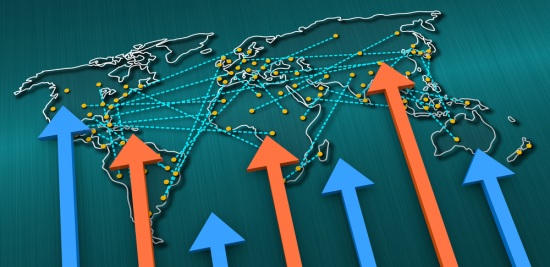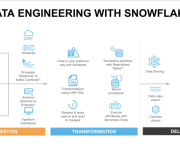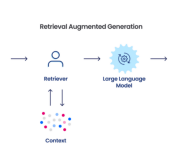Virtual and Augmented Reality: The Future of Big Data Visualization?

Although there have been multiple improvements to both the collection and visualization of big data in the last few years alone, including the implementation of 3-D spatiotemporal interactive data visualization software, some believe this data visualization can even go one step further and delve into the vast world of Virtual Reality and augmented reality. However, others believe that this format could prove to be even more difficult than the basic big data visualizations of today and would ultimately be a step in the wrong direction when it comes to improving the way we currently look at big data.
Therefore, in order to fully understand how virtual and augmented reality could be utilized in big data visualization, we must first stop and ask ourselves “how the virtual reality visualization of big data could be accomplished, who is currently at the forefront of this future interface software, and what are the pros and cons to the utilization of said virtual and augmented reality when analyzing big data? Once we have answered these questions, we will finally have a deeper understanding of how this software would work, how it could improve modern big data analysis, and what to be watching for in the next few years regarding its slow rise in popularity.
How Can Virtual and Augmented Reality Be Used To Visualize Big Data?
In 2016 alone, over 6.3 million VR headsets were shipped worldwide. Although the original primary use for said headsets was in the gaming industry, this did not last for long, as people began to recognize the immense potential said headsets had and how they could be utilized in a professional setting. In fact, one of the first uses for the virtual reality headset in the business industry came in the form of virtual modeling. Through virtual model visualization, designers were able to actually interact with their models and find flaws in a virtual setting without wasting the materials that traditional model building did in the process.
Since then, multiple companies have sought to manipulate our senses and utilize olfaction, sonification, and vibration in order to create a more realistic virtual world. With the incorporation of motion trackers such as the Vive tracker alongside haptic glove technology, companies are now able to not only visualize models but touch them with their hands which opens up a whole new level of opportunity in the virtual visualization market. For big data visualization, this meant that a future was probable in the virtual and augmented reality world.
In order to recognize the various benefits to implementing virtual and augmented reality interfaces in the visualization of data, we must first take a look at the data visualization tools currently on the market and the limited options they provide. During the October, 2016 Data Science Meetup, a representative from the revolutionary VR/AR company, Meta Augmented Reality, talked about just that. According to Meta, “Existing tools leave a little to be desired.”
Meta talked directly about some of the setbacks current big data visualization tools have and how augmented reality can tackle these issues one by one. For starters, the current tools on the market are often limited in size by media. This means that you either are forced to drill down data sets or crop them, which can be frustrating and relies on you being able to retain all of this information in your head as you view it. Furthermore, if you don’t do this, it will overload the working memory which makes the process far more tedious and tiresome.
However, perhaps one of the most ineffective aspects of current data visualization software comes in the form of the 3-D objects it deals with. Although it is able to principally create the illusion of three-dimensional objects, this is solely through the use of monocular depth cues, which trick your brain into believing certain items are closer than others, thus creating a 3-D environment. Unfortunately, the human mind may be tricked temporarily, but these 3-D depth cues are not very accurate, and they therefore often require workarounds.
After reviewing this data, Meta recognized the flaws in traditional data visualization interfaces and set out to build an augmented reality headset that utilized principles in neuroscience and vision science to create the most natural interface possible with their computers. Although this is merely one example, multiple companies have turned towards this initiative in order to create far more effective and interactive data visualization systems, and the progress even now is immense.
Who Is Leading This Big Data Visualization Revolution?
Recently, EU researchers at CEEDS (Collective Experience of Empathic Data Systems) successfully transposed big data into an immersive, interactive virtual environment at Pompeu Fabra University in Barcelona. Known as the eXperience Induction Machine, this device allows users to step into large data sets in order to visualize data in a more “empathic” way, which will allow large data sets to be understood far more easily by individuals due to the way the brain functions with numbers and visualization.
However, perhaps one of the most impressive incorporations of big data analytics into a virtual reality environment comes from the company Virtualitics. Founded in 2016, the company initially made $4.4 million in funding, and for good reason. Unlike many data visualization tools both from the past and in the VR sector, Virtualitics data visualization interface also incorporates AI to formulate a system that uses smart mapping, smart routines, machine learning, and natural language processing to identify important patterns and display them in the virtual environment, which can then be customised by users. If this wasn’t already impressive enough, the user can examine up to 10 dimensions of data at a time, making it one of the most effective and intelligent designs created thus far. However, even with this said, this new technology still has a ways to go and so many opportunities for improvement and advancement through the incorporation of other forms of modern technology.
For instance, when virtual reality model creation began to take hold, students and researchers at the University of Illinois developed perhaps one of the most fully immersive model visualization systems currently on the market known as CAVE, or Cave Automatic Virtual Environment. The system puts users in a completely immersive virtual world that is scalable and easy to manipulate, which means that the objects within it can ultimately be visualized in a far more effective manner than a regular 3-D virtual model.
Furthermore, with the incorporation of tracking devices such as the HTC Vive Tracker, which became available to developers in March of this year, as well as haptic gloves such as Neurodigital’s GloveOne, which is fully compatible with the HTC Vive Tracker, the possibility to not only click on particular data points and enlarge them but to also touch these objects and feel them in your hands is truthfully only a few steps away from being the next giant leap for big data visualization.
With this technology in place, it could very soon be possible to also create interoperable data repositories for Collaborative Work Environments (CWEs), which would allow whole departments or teams to collaborate in virtual and augmented environments on projects as a team.
A good example of this can be seen through software developer Drew Gottlieb’s project he dubbed “mixed reality” in which he was able to use virtual reality headsets and transfer virtual 3-D objects into an augmented reality setting. Through this, Gottlieb was able to interact with simple blocks he created in an office space alongside his co-worker. By watching this, we can see how this kind of data visualization and collaboration could be a great way for teams to not only gain a better understanding of the big data they have collected but determine ways to use this data to their benefit in a fully interactive and team-oriented manner.
Lastly, another large advancement in virtual reality digital visualization comes from the company VMware which is a subsidiary of Dell Technologies and specializes in cloud computing as well as virtual data visualization. One of the most established virtual data visualization companies on the market, they may not be rushing to advance their technology, but this technology does happen to be stable and reliable, which is something multiple other sources simply are not at this point in time. However, with any new tech, there are always things that can be improved, and it is important that we recognize these improvements and seek to make them as often as possible so as to grow and expand this otherwise highly promising market.
What Are the Negative Aspects of Virtual and Augmented Reality Data Visualization?
There are two main issues regarding virtual reality big data visualization that have yet to be resolved. However, these two main factors are not only common concerns in the tech industry but also certainly capable of being fixed. The first being that virtual reality headsets still do not have the kind of security settings that various other forms of technology do — due in part to the initial demand for these headsets, which led to certain security standards being ignored in order to get the production ball rolling.
On the subject of supply and demand leading to security issues, Ben Smith, CEO of Laduma, stated, “As new developments are rushed to market in order to gain a lead on competitors, there is a risk that mistakes are being made.” The truth is that devices which are connected to the cloud as well as various other weak devices which also connect to personal information can be highly dangerous. Furthermore, once this weak software becomes an integral part of a company’s analytics process, this means that these weak devices will not only be connected to the analytics of the entire company but various other pieces of tech with personal information within them. With this said, these devices can quickly become dangerous and lead to major malware and cyber attacks directed at your company and its sensitive data.
A perfect example of this can be seen during the major Mirai Malware attack of 2016 that was the largest of its kind. This DDoS attack on DNS service provider Dyn led to multiple major companies and their products being inaccessible for nearly an entire day. Although this attack may sound as though it was derived from some serious hacking and cleverness, the truth is that it all began with a series of weak cell phones and cameras connected to the cloud. Once one cell phone was infected, when the owner used calling connected to his Wi-Fi and overall cloud network, it led to more devices being infected with the malware botnets. After time, the infection had spread to the source, Dyn, and the hacker was able to manipulate the botnets into doing as they wished.
However, as new versions of the original VR headsets hit market and patches to help fix security settings do as well, it is highly unlikely that these issues will remain for much longer. With secure headsets and devices that are equally secure connected to the cloud, companies can rest assured knowing that one of the two main issues has been resolved, and their analytics will be all the more secure because of it.
As for the second main issue with virtual reality big data visualization, there is a slight concern arising that these devices could potentially lead to data loss if the interface were to overload with too many data sets at once. The data loss itself may not be that big of an issue due to data recovery services, but this is actually where the issue lies. Although there are a few quality virtual data recovery companies out there that work with systems like VMware, such as Kroll Ontrack, the list of these companies is fairly short and few. Furthermore, it is not recommended that you try to have data recovered in a virtual interface if the company is not qualified to do so. However, with the popularity of this form of big data visualization rising daily, it is certainly possible that more data recovery services will begin to accept VR data interfaces and that the interface itself will become more capable and less likely to suffer data loss.
With this said, this is merely a minor issue to consider as the wonderful possibilities of virtual reality data visualization unfurl and nothing to be seriously concerned about in the long run. In fact, with so much opportunity on the horizon and a chance to finally visualize big data in a fully interactive and engaging manner, there is very little to be concerned about at all as you, your team, and your company will soon be able to take your analytics process to a whole new level and reap the myriad lucrative and progressive benefits because of it.



























